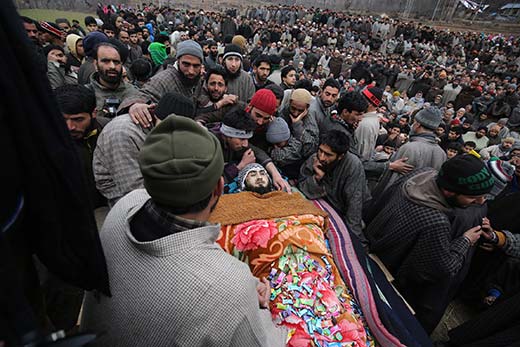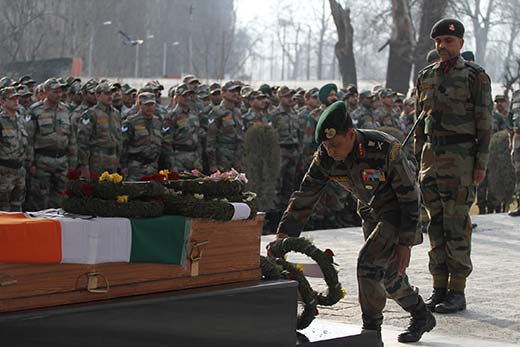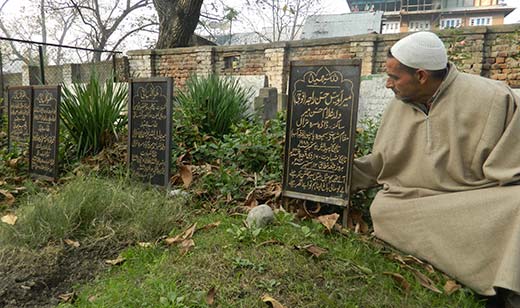Amid claims of Kashmir bouncing back to halcyon days, army sees Tral as the new ‘militant hotspot’. The latest clash saw two fresh militant recruits killing a colonel and an SOG man. After spending a few days in Tral and refreshing his memories of 1990s, Bilal Handoo reports the cycle of action and reaction that keeps the pot boiling

Pic: Bilal Bahadur
Inside a makeshift tent, father of Adil Shah of Rathsuna village of south Kashmir’s Tral was unable to conclude how his obedient son became a Mujahid. He sat quiet amid screams and sobs. A torrent of people – both Muslims and Sikhs – stepped in and out of the tent, shaking hands and expressing sympathy with him. Almost everyone advised the bereaved father of the slain militant to maintain patience.
This scene was unfolding inside the Shah house of Rathsuna on June 22, 2014. That day Rathsuna, like other parts of Tral, was grieving amid complete shutdown. The trigger was the killing of Adil Shah, along with two other Hizbul Mujahideen militants, on June 19. The death ended a 26 month long period of Adil’s disappearance.
Adil was pursuing diploma in paramedics from Pulwama until April 17, 2012. That day, he routinely left home for college, but never returned. “We filed a missing report,” his father Abdul Ahad Shah said. “A few days later, army showed up and took all his photographs and documents.” Before the family could make sense of that search operation, army broke the ‘shocking’ news: “Your son is an active Hizbul Mujahideen militant!”
“He never let anyone sniff about his activities,” the father continued. “His gentleness and devotion to Islam didn’t create any doubt about his intentions. But I have no regrets. It was Allah’s will.”
Nearby in Ladibal village, people were silently stepping in the residence of another slain militant, Tariq Ahmad Parray. His father, Ghulam Mohammad Parray, a government employee, was sitting in a room packed with mourners. His son was pursuing Masters in Institute of Kashmir Studies at Kashmir University who went missing in the summer of 2013. “Later we came to know that he has become a Mujahid,” the grieving father said.

Pic: Bilal Bahadur
Tariq wasn’t inclined to militancy, but was pushed to it, claimed Parray. “My son was a very sensitive person. Police picked and tortured him in early 2012. His laptop worth Rs 40 thousand was also seized. Not everyone can tolerate highhandedness. He was like any other boy in his village until the custodial torture changed him completely. He would then raise questions like: why Kashmiris often face harassments?” he said. “He was about to appear in KAS exams, but he was pushed to the extremes.”
In August 2013, Parray saw his son one last time when Tariq left home for university. Soon university authorities informed Parray: “Your son isn’t appearing in exams.” The father went to Srinagar and found Tariq missing from his rental room. He found no trace of him until on June 19, 2014 he heard some militants have been killed in an encounter, hardly knowing, one of them was his own son.
These summer killings had set off a wave of anger in Tral. In an uncalled unison, the town with traditional houses, green fields and woods had observed a shutdown. At number of spots, army men were busy frisking and checking. Near Dadsara village, a group of angry boys were pitching, “Shaheed ki jo mout hai (The death of a martyr)?” Others responded, “wo qoum ki hayaat hai (Is nation’s subsistence).” Amid shutdown, security-checking and slogans, Tral was breathing another day.
The angry boys were stepping inside the martyrs’ graveyard in Dadsara. There were total 37 “martyrs” resting inside. These boys fell silent near a fresh grave. Inside that grave rests the third slain militant, Aadil Bashir Mir. Aadil, who rose through ranks to become Hizb commander at the age of 25, was killed on June 19, 2014 along with Adil Shah and Tariq Parray. Those boys offered prayers and walked away, wiping out their moist eyes.
Nearby, people were walking inside Aadil’s residence. They assembled inside a makeshift tent erected on a lawn. A man with long flowing beard was delivering a sermon. “This life is an illusion,” the man almost shrilled. “Aadil has now passed into the real and eternal world…” Just a few steps away, Aadil’s family members were huddling inside a room to recount the making of two “martyrs” in their family.
Before Aadil joined militancy in the fall of 2010, his elder brother Nayeem Mir had become a Mujahid in 2009. A B. Tech student, Nayeem could sense sleuths stalking him because of his militant cousin. “He perhaps sensed threat and disappeared,” Bashir Ahmad Mir, his father said. In September 2010, Nayeem was killed in an encounter. And within a month, his brother Aadil Mir followed his footprints.
Aadil shortly rose to the position of Hizb’s divisional commander and figured in the ‘most wanted’ list of state forces. It is said that Aadil carried number of attacks on government forces until he was killed along with Adil Shah and Tariq Parray in an hour long gunfight in Busoo, Tral on June 19, 2014.
The next day, amid pro-freedom and anti-India slogans, almost entire Tral turned up for the funeral processions. “The sacrifices rendered by people of Kashmir in general and Tral in particular is unparalleled,” Muhammad Ashraf Sehrai, Hurriyat (G) leader, who had turned up for the funeral procession addressed people of Tral.
Aadil was a closest cousin of Burhan Wani, son of a school principal. “Both Adil and Burhan were childhood friends,” Mir said.

Pic: Bilal Bahadur
In later part of 2010, a Class 10th student Burhan Wani of Shareefabad Tral was having a joy ride with his younger brother Khalid in Amirabad Tral. “We were on a bike,” said Khalid, a look-alike of Burhan. “STF personnels nearby stopped us and forced us to bring cigarettes and a packet of snacks. We did as ordered. But before letting us go, those cops winked at paramilitary personnel playing cards nearby, who swiftly pounced on us.” While Khalid fainted on the spot, Burhan managed to run away through a nearby graveyard, screaming: “I won’t leave you now!”
That day when Burhan returned home, he was repeatedly screaming: “I won’t rest in peace till I teach them a lesson!” These words from an otherwise calm and composite son of the Wanis of Shareefabad were alarming. “Everybody tried to pacify him. In fact, we promised him: ‘Just forget it. Be ready, we will send you away from all this. You will study either in America or England,’ ” Khalid continued. “But it was too late, very late in fact. He had made up his mind. He was badly hurt. He left home only 10 days before his class 10 exams.”
Soon Burhan, 15-year-old enthusiastic cricketer and first-rate student, became the ‘most wanted’ Mujahid of Tral. He was one of the youngest militants at the time of his joining. “There is bounty of Rs 10 lakh on him,” one police official said. In spite of all this, Burhan occasionally visits home to meet his mother. “Police is directing us to mix sedatives or snatch weapons from Burhan whenever he visits home,” Khalid said, “but is it possible for a mother, father or brother to do that?”
Many on ground zero believe that guerrillas like Burhan, with boy-next-door looks, carrying an AK 47 glamorised the militancy. “It sounds romantic that a local boy with chocolate-looks dares mighty India,” feels Firdous Bhat, a local from Noorpora, Tral. “In fact Shaheed Aadil Mir was ruling over imaginations of youth in Tral.”
Bhat’s assertions were quite evident on ground. Three friends, returning from Aadil Mir’s residence after paying obeisance, said: “Today, we lost our hero!” Studying in Class 11, the trio hailing from the main market area of Tral maintained that there was a “conspiratorial angle” behind Aadil and other two militants’ killing.
One ‘stark’ observation goes: behind the brewing situation in Tral, there is a multi-factorial trigger rooted in sentiment, ideology, family history, geography and “state excesses”. Amid all this, a perpetual cycle of violence is still unabated in this fairly literate town of Pulwama district.
One among the many factors is said to be the ‘resolute’ home-grown guerrilla outfit Hizbul Mujahideen, still a dominant group in the area. “Over the years as militancy waned in other parts of valley, Hizb survived in Tral,” said Showkat Bashir, a teacher in Tral. “It is one of the reasons why the foreign militant outfits like Jaish-e-Mohammad (JeM) aren’t making inroads in the area.”
Bashir cited instances of Johar Ali from Malangpora Tral killed in shootout with army in 2008. “He was a Hizb militant,” he continued. “Besides him, another Hizb militant, Jan Mohammad Ahangar alias Hamzah was killed while fighting with Army in Pulwama in 2009. In 2010, Massiullah, a Hizb militant, was killed in Dudhkulan Lurgam encounter…”
But the police officials believe otherwise. “JeM and Hizb act in unison in Tral,” the police source said. “Presently, around 12 local JeM militants are active in Tral other than HM militants.” In fact, new recruitments mostly happened in 2014 than before, asserted AG Mir, inspector general of police (Kashmir): “Most of the active outfits have recruited youth.”
A senior rank police official said a ‘spurt in militancy’ in Tral is aided by its geography. Located at an elevation of 1662 metres, almost all 82 villages of Tral (spanned over 110 square kilometres) are known for its snow peaks, natural springs and dense forests. “Many areas in Tral are still inaccessible due to dense forests. These spots are safe-haven for a small number of the new militants who seem highly motivated and resolute than their predecessors of nineties.”
Besides geographical factor, the official said, there is a sentimental issue “which is mainly stoking the jihad sentiment” in the area. “And that particular issue is something which can’t be brought under control through policing. It is beyond normal policing. The role of police comes after the reaction, which in fact, makes our job very tough,” the official said.
“The violent path adopted by the Kashmiri youth is neither any act of hobby and nor an outcome of the unemployment,” believes Syed Ali Geelani, Hurriyat (G) chairman. “They are the students of different colleges and universities who are fully aware about the historical perspective and the tragedy of Kashmir.”
Tral like other parts of Kashmir was believed to be the land of non-Muslims until Syed Ali Hamdani (RA) came from Khatlan, purchased Tral with three pearls and spread Islam. The state authorities now blame the “religious radicalisation” in Tral for renewing militancy spearheaded by youth.
“It sounds like an old maxim: give a dog a bad name and hang him,” said Tanveer Dar, a graduate from Dadsara. “To say, religion is fuelling freedom sentiment among youth is, I believe, a myopic state vision. Does state wants to give an impression that people of Tral are more religious than others? And that their religious devotion is forcing them to be up in arms against the state? Being a good Muslim has nothing to do with the issue stoked by state excesses and heightened militarization in the area. State often turns its eye blind to these factors that create resentment among youth. I believe, state need to wear impartial glasses to see Tral.”
The much-talked about ‘instigating factor’ – the three consecutive summers between 2008 and 2010, also seem to simmer Tral. “Apart from killing 120 young Kashmiris, hundreds were hounded by the security agencies which badly distressed youth,” believes Jasbir Singh, a resident of Tral. “Those counter-protest methods of state have now backfired. Now pent up feelings among youth are drawing them to the position where they want to settle the scores with guns like their predecessors did in nineties.”
When guns started blazing in Kashmir during nineties, the major factor was the “sentiment of Azadi”. Similarly in Tral, many say, the same sentiment is still motivating youth to become Mujahids. “For me,” said Kaiser Ali, a Class 12 student of Amlar Tral, “Kashmir’s Azadi is a holy cause.” There is a strong belief among youngsters, he continued, that it is sheer cowardice to keep suffering in the face of oppression. “Such thoughts are only making youth restless amid excesses they face at the hands of Army and police,” Ali said.
“Police did commit certain mistakes in past, which can’t be undone,” a young SOG (special operations group) officer said. “Those mistakes have indeed led to spurt in militancy apart from other factors. But I think, a new face of policing is need of an hour. Besides police need to show empathy than sympathy to strike a change in Tral.”
Amid all this, Tral continues to be a poll-boycott zone. Many call it Kashmir’s Kandhar (Afghanistan), where nothing much has changed since nineties. “Akin to nineties, the crushing security measures are still in place in Tral, which further create resentment among youth,” said Sajjad Khan, a resident of Shareefabad. Perhaps, the same ‘grim’ situation of Tral made Geelani to caution: “Due to the stubbornness of India, a different mentality is developing among the younger generation of the Kashmir and it will be uncontrollable for everybody.”
And to address what Geelani termed a “different mentality” in Tral belt (emerged as “the new militant hotspot,” as per army), GoC Northern Command, Lt Gen DS Hooda landed at the headquarters of 42 Rashtriya Rifles in Bajwani Tral in 2014 summer. He chaired a meeting of senior Army officers where a new strategy was discussed to counter militancy. Later it became evident that Gen Hooda had directed army men in Tral to “intensify anti-militancy operations and focus more on human intelligence”.
Perhaps, it was the same “human intelligence” that lately led to the killing of two Hizb militants at Handora Tral on January 27, 2015. Hizb district commander Abid Khan had arrived at Handora village Tral to meet his family members. He was accompanied by his associate Shiraz Ahmed Dar of Warigund Tral. “We received inputs about their presence and without any delay, joint army parties from 42,180, 185 Rashtriya Rifles along with SOG Tral cordoned off the village,” the police official said. In an ensued gunfight, both Hizb militants were killed along with army colonel MN Rai and head constable Sanjeev Singh. Colonel Rai was awarded with Yudh Sena Medal a day before his killing on January 26 for his “exemplary service and bravery”.
“There appear to be dark clouds on the horizon,” cautioned Lt Gen Syed Ata Hasnain, a former GOC of the Srinagar-based 15 corps. Hasnain, who is a senior fellow of the Delhi Policy Group, said: “Incidents in Tral where the situation after the killing of terrorists deteriorate rapidly…is not unusual… but in Kashmir’s security landscape many things remain unnoticed… because of the inability to join the apparently unrelated dots.”
But in 2014 September floods, two “unrelated dots” (parted earlier by cause and ideology) did join in Tral. In the deluge, the slain militant Aadil Mir’s childhood friend Owais Hassan Mir, 25, was washed away. Owais was a Rashtriya Rifles personnel, now buried inside 38th grave in the martyrs’ graveyard of Dadsara adjacent to Aadil, resting inside 37th grave. Both grew up, discussed their life plans and applied for army posts, together. But perhaps much to their own disbelief, their lives soon took different courses.
In 2007, both friends in their teens had jointly applied for army jobs. While Owais secured the job, Aadil failed due to his failure to get a health certificate.
Meanwhile, Owais started taking part in several operations against militants. By the later part of 2010, Aadil had joined Hizb and carried attacks on government forces. Both operated in Pulwama. But as luck would have it, they never faced each other during a gunfight. By towing opposite lines, two friends had become the de-facto opponents of each other.

Pic: Abdul Qayoom
Owais was washed away three months after Aadil’s killing. At first go, he was denied space inside the martyrs graveyard because of his army background. But after it was known that everyone suffered alike in the floods and that Owais had rescued many people before his boat capsized, he was allowed to rest close to his best friend. But Owais, who was given a guard of honour by an army team, became a different martyr. A glaring difference can be seen engraved on their tombstones: Aadil is “shaheed” and Owais, a “fauji shaheed”! And unlike his “shaheed” friend, not many turned up for the funeral of “fauji shaheed”.
Maybe this tale of Tral – where ‘pro’ and ‘anti’ seem fiercely engaged with each other – is unwilling to end with Aadil and Owais itself.
















Beautifully written piece that took me to the land of my dreams. It also makes me believe that Kashmir’s armed struggle born out oppression and inhuman excesses of Indian army
Where is the Governance? Where is the Justice? Govt. only has time to make plans for pandit homeland, settle West pakistan refugees, demolish article 370, change the demography of J&K…You are pressing a spring and at one moment it will bounce back and jump above your head…Don’t hold sand too tightly in your hand, when you will open the hand you will have nothing there! wake up World come to the rescue of kashmir